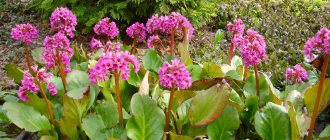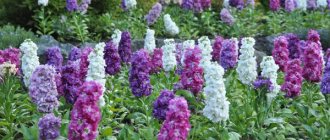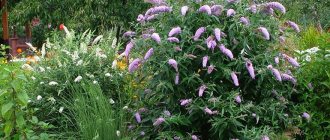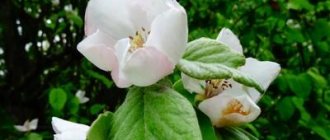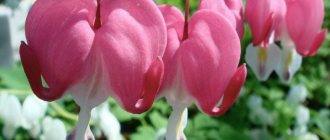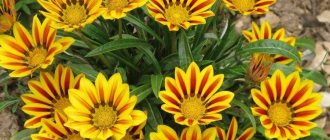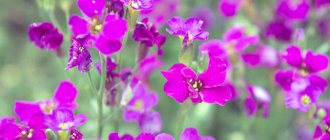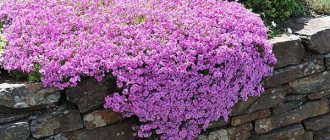The attention of gardeners is attracted by the amazingly beautiful flower of the nightshade family, salpiglossis. Simple cultivation of salpiglossis from seeds is accessible even to novice amateurs. The plant has a strong external relationship with petunia and bluebells. Cultivated as a perennial, biennial and annual, depending on the region. The name is in Latin Salpiglossis, translated as “tongue” and “pipe”. This is where the second name for salpiglossis arose - tubal tongue.
Description of the plant
Salpiglossis is a genus of perennial and annual plants belonging to the nightshade family. It includes 2 species found in the southern Andes, from Chile and Argentina to southern Peru. These plants grow naturally in deserts and dry, rocky mountain slopes. The genus came to Europe in the nineteenth century, and now it can be found in many gardens.
One species, Salpiglossis sinuata, is cultivated as an ornamental plant. It is very diverse in flower color; many decorative varieties have been bred.
The genus name Salpiglossis comes from the Greek language. The word is formed from two words:
- "salpinx" means "pipe";
- "glossa" means "tongue".
This is due to the structure of the flower, the lower petals of which merge into a funnel-shaped tube, and the upper ones resemble a tongue. Salpiglossis has many interesting names:
- In English-speaking countries it is called painted tongue, which means “painted tongue” or tube tongue.
- In Spain, the plant is translated as “Bitter Stick” (palito amargo) or “Velvet Trumpets” (Trompetas de terciopelo).
- In France it is called Trompette de velours or "Velvet Tube", apparently for the delicate pubescence on its bell-shaped flowers.
Botanical description:
- Annual and perennial plants up to 60 cm tall. In our climate it is grown as an annual plant. The species cannot withstand temperatures below -8-10 °C.
- The stems are quite thin, slightly sticky, branched at the top. They have a huge drawback - they break very easily.
- Leaves – the upper leaves are broadly lanceolate, single, with a wavy edge, soft, sticky with glandular hairs, located on petioles. The lower leaves are toothed, the entire upper edge is slightly wavy, covered in sticky hairs. At the bottom, the lobed leaves resemble oak leaves, and at the top they almost form bracts.
- Flowers - located at the top of the shoot in loose clusters on long stalks. Five-lobed. The calyx is tubular. The crown of the flower consists of petals, usually fused along the entire length, funnel-shaped, with four equal sections and one wider one. The color is different - yellow, red, dark purple. The petals of the species Salpiglossis sinuata have distinct veins, which increases the attractiveness of the flowers. The flower reaches 5 cm in diameter. There are 4 stamens of equal length. Flower buds are pubescent, twisted, on a long petiole.
- The fruit is a capsule with two opening valves, containing a large number of small seeds.
- Roots - the plant has a fibrous root system, but since the species lives on lands from which moisture drains quite quickly, its roots are quite thick and accumulate water.
Salpiglossis grows into an erect bushy tuft 40-80 cm high and 40 cm in diameter, which tends to expand. Like the petunia, to which it is closely related (they belong to the same family and are sometimes confused), the entire plant is covered with fluff that is sticky to the touch.
Flowers range from large to very large. They can have a diameter of more than 10 cm. Flowers grow on long stems from the axils of the leaves. Pleasantly scented, velvety tubular flowers, reminiscent of petunias, bloom in loose clusters at the ends of the flower stalks. Salpiglossis flowering period: from July to frost. The yellow flowers bloom first, the rest bloom at intervals of one week. The plant is characterized by flowers of many colors, from orange to red, blue and purple. They are often two-colored and the centers are usually yellowish.
What do salpiglossis seeds and seedlings look like?
Salpiglossis - annual plant
The Solanaceae family is native to South America. The seedlings of the crop have erect thin stems, in adult form they stretch up to 50-100 cm. There is almost no branching, the shoots are covered with short, stiff hairs, the root system consists of a main rod and developed lateral processes.
The leaves of the seedlings are dark green, oblong in shape, on petioles. The edges of the plates can be smooth or jagged. In mid-summer, a strong plant bears large single funnel-shaped buds of yellow, blue, red or purple hue. There is a beautiful marble pattern on the petals.
Salpiglossis fruits are oval capsules. The seeds of the plant are small and light, irregular in shape and dark brown in color. They remain viable for quite a long time - they can be used for planting for 4-5 years.
When grown, salpiglossis blooms from July to September.
Types and varieties
The genus Salpiglossis is represented by only two species:
- Salpiglossis sinuata (lat. Salpiglossis sinuata) - grown in gardens and on balconies as an ornamental plant.
- Salpiglossis spinescens (lat. Salpiglossis spinescens) is endemic to the Andes mountains in northern Chile in the very dry region of the Atacama Desert.
Salpiglossis notemata is grown in flower beds and, in cooler climates, in greenhouses. Requires sunny locations and permeable, moist soil. Sensitive to frost and susceptible to aphid attack. Propagated by sowing seeds in the ground in early spring (seedlings do not tolerate transplantation well).
Mostly hybrids are grown, differing in height, color, and flower size.
The most popular varieties:
- “Bolero” Bolero is an F2 hybrid, 90 cm high, the flowers are colored in warm shades from copper yellow to golden yellow and red.
- “Carnival” – height 45 cm.
- "Casino" - scarlet flowers with a yellow neck, about 40 cm high.
- “Festival” – grows to 35-40 cm.
- "Flamenco" Flamenco is an interesting variety with two-color flowers, grows up to 40 cm.
- "Chocolate Royal" Chocolate Royal - with velvety dark red flowers, almost black at the core, yellow back wall of the neck.
- "Grandiflora" Grandiflora - 70 cm high, a mixture of yellow, orange-yellow, orange-rust, purple and violet tones, blooms a little later, in July-August.
- "Kew Blue" Kew Blue - with magnificent violet-blue flowers, dark blue throat.
- “Royal Mixed” Royale Mixed is an F1 hybrid, 55-60 cm high, in colors – yellow, orange-yellow, orange, purple, violet, blooms for a long time from June to September.
- “Superbissima” Superbissima - distinguished by large veined, grooved and marbled rims of different tones.
- “Bouquet” is a 40 cm high variety, very compact, available in blue, yellow or red.
- “Chocolate” is a 60 cm tall variety with purple-brown flowers with a yellow center.
Salpiglossis in landscape design
Salpiglossis, due to its decorative effect, is widely used in landscape design. In group plantings in flower beds or garden beds, and also adjacent to:
- petunias, especially white ones, as a bright accent;
- salvia;
- cineraria;
- marigolds (you can effectively decorate a gazebo or flowerbed);
- decorative cabbage;
- Matricaria;
- chrysanthemum;
- coniferous plants.
Flowers look great in bouquets. They do not wither long after cutting, maintaining a very attractive appearance.
Experienced designers advise planting salpiglossis along paths. They note that the culture is good in the foreground of the flower bed. If you remove the plant too much, you will not be able to admire its unusual flowers.
The photo of salpiglossis fully conveys the beauty and unusualness of this southern plant. Shows how it will look in the garden and decorate it. And thanks to the abundance of colors, this flower can be safely used when creating a monochrome flower bed.
Requirements for planting site and soil
Salpiglossis loves the sun; only a sunny place is suitable for it. Flowers open only in the presence of sun. Due to the fragility of the stems, the area must be protected from strong winds.
Salpiglossis can be sown in greenhouses almost all year round, but it can only grow and flower at temperatures above 15°C.
In nature, salpiglossis grows in the mountains and is adapted to mountainous areas. It requires permeable soils. If there are puddles in the area after heavy rain for more than an hour, this place is not suitable; the plant will quickly die in such a place. This sensitivity to excess water causes the plant to become weak and bloom poorly in cold, wet summers. Therefore, you need to choose a flood-proof area; you can plant salpiglossis on a small slope and make drainage in the soil.
Salpiglossis needs soils with average fertility. As a fertilizer, it is enough to mix the soil with a layer of compost. Salpiglossis tolerates limestone well.
So the soil for salpiglossis should be:
- fertile, but not excessively, because then it blooms less;
- constantly moderately moist, but permeable;
- with a neutral or slightly alkaline reaction.
Diseases and pests
Salpeglossis is susceptible to fungal diseases, which most often appear due to high soil moisture.
Therefore, the soil in the flower garden needs to be loosened regularly and its moisture monitored. It is almost impossible to save a diseased plant. But you can try treating it and the soil around it with fungicides. Great harm is caused to the bush by aphids, which settle on its tops and feed on the sap of the plant. As a result, first the flowers and leaves wither, and then the bush itself dies. Insecticidal preparations are used to control aphids.
Sometimes the tubetongue becomes infected with whitefly , which also feeds on the sap. The pest loves high air humidity and high temperatures, so it is most often found in greenhouses and conservatories.
To prevent the appearance of pests, you can use a concentrated infusion of garlic or onions, spraying them on shoots and leaves.
Landing
You can grow seedlings yourself from seeds; below is how to sow seeds or buy them. Salpiglossis seedlings are planted in flower beds in open ground when the frosts pass - in mid- or late May, depending on the region and weather.
You can also sow seeds directly into the ground at the turn of April and May so that the plants sprout after spring frosts. This method of cultivation significantly delays flowering. This method is only suitable for warmer regions of the country. It is necessary to sow no earlier than the beginning of May, because the seeds germinate in 2-3 weeks. Flowering occurs 8-10 weeks after sowing.
Under good conditions (moist soil that does not freeze too deeply), the seeds remain viable in the ground for up to 4-5 years. Therefore, a year later you can suddenly find self-sown seedlings if the faded flowers were not pruned and they were given the opportunity to set seeds.
When preparing the site for planting, add compost to the soil in the amount of 1 shovel per plant.
When planting salpiglossis seedlings, do not plant them closer than 15-20 cm from each other. If salpiglossis is planted from seeds in open ground, the seedlings will have to be rooted out so that they do not grow too densely. The uprooted seedlings can be planted elsewhere. But they don’t like replanting; even if they take root, the plants will be weak. The thickened roots of the species cannot withstand damage.
Since it is a mountain plant, it likes the roots not to heat up, so after planting the soil around it needs to be mulched. If the soil is fertile and the variety is tall, plant staking may be necessary. Since they are quite tall, it is worth planting them in the background. After the plant planted in front of them becomes a kind of support, we will see only salpiglossis flowers.
3 plants are planted in a pot with a diameter of 30 cm of the same or greater depth. A layer of drainage (pebbles, expanded clay) must be poured onto the bottom of the pot.
Growing salpiglossis from seeds to seedlings
Algorithm for planting seeds for seedlings:
- Place a drainage layer on the bottom of the container - small pebbles, pieces of foam plastic, expanded clay.
- Fill the container with soil mixture and moisten it with clean water from a spray bottle.
- Place 3-5 seeds in each cup. Lightly press onto the surface without digging in. If one planting container is prepared, then the seeds need to be distributed using a toothpick.
- Re-moisten the crops.
- Place the cups on one common pallet or tray. Cover with film or glass.
- Transfer to a windowsill where there is no direct sunlight. If such a place cannot be found, then you need to shade future shoots with a sheet of white paper.
The air temperature should be maintained in the range of +20°С…+22°С.
Salpiglossis seeds do not need stratification or pre-planting preparation. They initially have high resistance to pathogens.
Reproduction
You can collect the seeds yourself. We leave a few flowers without cutting them so that the fruits ripen. Small capsules will form, when they turn beige, cut them off and place in a paper bag.
First of all, you need to know when to sow salpiglossis seeds. It is optimal to sow at the end of March. Seedlings need long daylight hours to develop.
Growing salpiglossis seedlings:
- Although the plant is not susceptible to frequent diseases, seedlings can rot due to fungi dormant in the soil or on the seeds. Therefore, it is advisable to treat the seeds before sowing with a seed dressing fungicide, for example, Funaben or another preparation.
- Seeds are sown for seedlings in boxes filled with universal soil. Since the seeds are very small, do not cover them with soil, just press them into the soil with a small board or by hand.
- The boxes are kept in a warm room until germination in the shade at a temperature of 18-25 °C, which may take 8-30 days.
- After the seedlings appear, the seedlings are placed on the windowsill and watered moderately.
- When the seedlings have the first 2 true leaves, they are planted in separate pots or cassettes with holes 3 cm in diameter. It is better to hold the seedlings by the leaves rather than by the stems, they are very fragile. Since the plant does not tolerate transplantation well, it is better to use peat pots, which will then allow the seedlings to be transplanted into the ground without injury.
- Since the daylight hours are short at the beginning of spring, it is better to keep the seedlings at a temperature of 18 °C so that the seedlings do not stretch out. Or you need to highlight the plants.
- Before planting in open ground, seedlings need to be hardened off - start taking them outside for a couple of hours. Over the course of 1-2 weeks, the hardening time is increased so that by the time of planting the seedlings are accustomed to outdoor conditions. It is brought into the house at the end of hardening only for the night.
Salpiglossis seedlings can be planted in open ground when the danger of return spring frosts has passed. Depending on the region, this period begins in mid-May or later. You need to wait until the soil warms up and there are no large temperature changes. This heat-loving plant is one of the last to be planted in the ground.
By growing salpiglossis in seedlings you can get flowers in June. If you sow salpiglossis seeds directly into open ground in the middle or end of May, you will get flowering plants no earlier than July.
When the seedling grows 5 leaves, you should pinch it - cut off the top, this technique contributes to good tillering of the plant, it will produce many new side shoots. Many side shoots are expressed in many colors.
Sowing seeds
In the middle zone it is better to grow a flower with seedlings. The seeds are highly resistant to diseases and pests, so they do not need to be processed. The plant prefers neutral, slightly acidic soil. It is recommended to sterilize the substrate in a water bath or in the oven for about 40 minutes. You can also purchase ready-made soil for flowering plants in the store.
The time to plant seeds for seedlings is early March:
- Prepare wide, shallow containers.
- Pour loose soil containing turf soil, sand, ash in proportions - 2: 1: 0.5.
- To reduce acidity, add a little peat.
- The soil is slightly moistened.
- Distribute the seeds over the entire surface, without sprinkling, only slightly pressing them into the soil. The distance is made greater.
- Moisten again with settled, warm water using a spray bottle.
If they are placed in separate containers, then put 2-3 pieces each (weak sprouts are then removed). Cover with film or glass. At home, choose a bright place where the temperature is +18…+20 °C. Place paper on top, if necessary, to protect the sprouts from exposure to direct sunlight. Seed germination is usually 80%.
Growing and care
Growing salpiglossis is not difficult if the flower grows in the right place, is protected from the wind and does not suffer from drought and standing water in the soil.
When growing salpiglossis there are 3 fundamental points:
- Sun,
- warm,
- drainage.
The plant does not like replanting; its roots do not recover well. Tall varieties should be supported and tied up; they may break.
Watering, fertilizing
Salpiglossis should be watered regularly, but moderately. It does not tolerate soil drying out and flooding. Watering is carried out, making sure that the substrate dries out between two waterings. Be careful that the water does not stagnate in the trays or flowerpots; the pots must have drainage, and the water from the trays must be drained.
The plant does not tolerate overheating of the roots, so the growing area must be well mulched with bark or compost. Thanks to this, we also reduce the evaporation of water from the soil and fight the infestation of beds with weeds.
It is best to fertilize salpiglossis immediately after sowing with compost mixed with garden soil - this is enough for the plant to grow well. Ideally, a year before planting, add manure to the soil before planting.
Trimming
During flowering, it is worth gradually removing faded flowers to limit fruiting and prolong flowering. Towards the end of July, it is worth pruning the stems of salpiglossis to give it a second wind.
Diseases and pests
Unfortunately, in cold and rainy summers, salpiglossis does not bloom well and often gets sick; the plant does not tolerate excess moisture. Like other nightshades, salpiglossis is sensitive to rust and powdery mildew.
Of the insects, aphids can pose a danger to the plant; at the first sign of its appearance, you need to wash it off with a soap solution or apply an insecticide in case of massive infestation.
Caring for seedlings (hardening, picking)
Seating from a common box is carried out during the appearance of a pair of real leaves. The picking is done very carefully so as not to damage the root system. The young plants are moved into peat humus pots so as not to create stressful situations for the plant anymore.
After transplantation, the specimens quickly begin to grow, and since the culture is high, it needs support. To do this, you can use supports for ordinary indoor flowers, which are sold in garden stores. After some time, it needs pinching in order to create more bushiness. If necessary, phytolamps are used.
Remember! Peat pots tend to dry out quickly, so it is better to place them in cut-off plastic bottles to retain moisture.
The hardening period begins from the moment the sprouts hatch. In this case, the film is not removed at all. At first, the window is opened for a short period of time, but so that there is no draft. Gradually, the time spent in the fresh air is increased, and the film is completely removed.
Application
Salpiglossis flowers are suitable for growing in garden beds and flower beds. Low-growing varieties can be grown in containers. Suitable as a cut flower - stays fresh in a vase for a long time.
They look most impressive in large groups, but they also grow well in boxes - on balconies and terraces. The salpiglossis themselves are delicate, the stems are a bit soft and do not form attractive clumps. They look especially interesting in the company of low plants that will cover its long shoots from below.
Salpiglossis can be used for planting mixed borders and flower beds in the company of other annual plants:
- eschsolzia,
- cosmos,
- dwarf dahlias,
- zinnias.
These flowers can be planted after the bulbous flowers have faded in the remaining empty spaces in the flower beds.
In combination with decorative tobacco it will create a very beautiful effect.
Where to plant salpiglossis?
When choosing a place for planting, it is important to follow the following rules:
- Salpiglossis in the flowerbed will bloom profusely if there is enough sunlight. If you plant the plant in the shade, the inflorescences will not be as bright.
- Excess moisture leads to rotting of the roots, so perennial salpiglossis should be planted in an area with a good drainage layer.
- The plant requires neutral or slightly acidic soil. Ordinary garden soil with the addition of peat or humus will do.
- Salpiglossis should be planted in a place protected from the wind.
Garden care
After planting in open ground, the following care rules must be observed:
- water daily with settled water;
- Spray the greens in the evening;
- after watering, loosen the tree trunk and destroy weeds;
- cut off wilted inflorescences, periodically pinch branches;
- fertilize twice a season (complex mineral fertilizers or wood ash).
If you follow these simple recommendations, salpiglossis will bloom until frost and will become a wonderful decoration for your garden.
Salpiglossis flowers - features
Salpiglossis: photo of flowers in a flowerbed
Unfortunately, despite the fairly wide variety of species of this genus, only one of them managed to become truly popular and widely used among gardeners, and it is called Salpiglossis notched. All other species grow mainly exclusively in the wild, but many gardener-collectors still value them very much and give them a special place in their plots.
However, we will be describing Salpiglossis notmata, since most likely, if you decide to get this flower, your garden will be replenished with a representative of this species. The shoots of Salpiglossis notched can reach a meter in height, but the length still varies, and therefore can be either greater or less. The shoots themselves are quite thin, especially for their size, and they also have a branched structure. In addition, small hairs can be found on their surface.
As for the leaves, they are quite narrow and face down. This especially applies to those leaf plates that grow closer to the buds. In addition, it should be noted that they are quite narrow, and therefore in the early stages of growth it may seem that the young leaf is a new branch of the stem.
The flowers, as already mentioned, have the shape of a musical trumpet. Also, for many, their shape can be characterized by a gramophone tube. They are small and reach no more than five centimeters in diameter, but the color can be completely varied: from sky blue to scarlet red. Pink and purple buds are also found.
Flowering is quite long: it begins in early summer and continues until mid-autumn. At the end of flowering, capsule fruits are formed at the tips of the peduncles, which contain seeds with which the plant can be propagated quite simply.
As we have already said, this plant is found both as an annual and as a biennial or perennial. However, unfortunately, in our latitudes and climate it is simply not possible to grow perennial Salpiglossis, and therefore in garden stores you will most likely be able to find seeds of only annual or biennial individuals.
Planting seedlings in the ground
Give salpiglossis a sunny area with fertile garden soil generously seasoned with humus. The soil reaction is preferably neutral or slightly acidic. Good drainage is necessary so that moisture does not stagnate. If your area experiences hot summer weather with extreme temperatures, choose a site with partial shade during the midday hours.
If there is no humus, you can add peat and a little ash to the holes, which will be sources of potassium, calcium, phosphorus and other trace elements.
Seedlings are planted using the transshipment method, taking care not to injure the delicate roots of the plants. To do this, the seedlings are watered a day before planting so that the earthen ball is moistened and easily comes out of the cup. It is best to turn the cups upside down and, turning carefully, simply remove them from the earthen clod.
We prepare the holes in advance at a distance of 25-30 cm according to the size of the earthen clod. We plant the seedlings, trying to maintain the same planting level; a slight deepening of the root collar is allowed. After planting, water the plants abundantly, but without stagnation of water.

